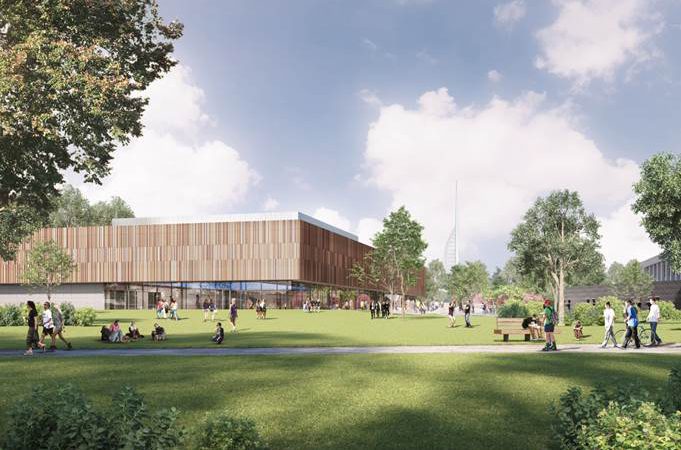Natural ventilation and light to reduce energy use and improve wellbeing of users at £53m facility, which just received planning permission
The architect working on the University of Portsmouth’s environmentally-friendly sport centre is using sustainable design to challenge the status quo around fitness centre comfort.
While most sports centre and gyms manipulate temperature to facilitate sport and exercise, the new facility – which is on target to receive BREEAM Outstanding certification for sustainability – will concentrate on air flow.
“We are trying to put forward an argument that in fitness areas, the comfort of the users is not necessarily only driven by temperature, but it’s more to do with air movement,” Irina Korneychuk, architectural designer at FaulkernBrowns, told The Sustainability Report.
She revealed that large fans would be integrated into the fitness areas to promote natural ventilation and airflow, allowing the university to save energy and money by not having to lower temperatures through air conditioning.
The plan is part of a wider strategy of using natural ventilation and natural light throughout the complex, in both the dry fitness and sport areas and the wet swimming pool section.
Korneychuk admitted that while none of the sustainability measures were “particularly innovative” standalone, the plan to bring them all together to create what is set to become the greenest sports centre in the UK is. As well as reducing energy consumption through natural light and ventilation, the centre will have a green roof with solar panels and bee hives.
To create the green roof, FaulkerBrowns is working with landscape architect DLA to “analyse the biodiversity and ecological value of the site”.
But the centre isn’t being built to this specification for environmental sustainability alone. The design has been devised to create wellbeing from a number of perspectives – particularly for the university’s student body. A large green park space will be developed around the centre to promote activity, exercise and relaxation.
The park will have no formal exercise equipment, but playful, inclusive apparatus. Inclusivity, said Korneychuk, will be at the heart of the building.
“We’ve been trying to push the boundaries for inclusivity in sports building,” she explained. “The traditional changing environment is very segregated – male and female – and doesn’t cater for families and transgender people. There will be no male and female changing rooms, just wet and dry, and everyone will have their own individual cubicle where they don’t have to undress in front of everybody.
“It provides more choice and I hope it promotes sport within some minority religious groups and among more transgender people.”
Portsmouth City Council has approved planning permission for the facility, which is expected to be complete by autumn 2020. The £53m centre will have an eight-court sports hall, an eight-lane 25 metre swimming pool, a fitness suite, multipurpose studios, squash courts, a climbing wall and a ski simulator.










Leave a Comment
Your email address will not be published. Required fields are marked with *